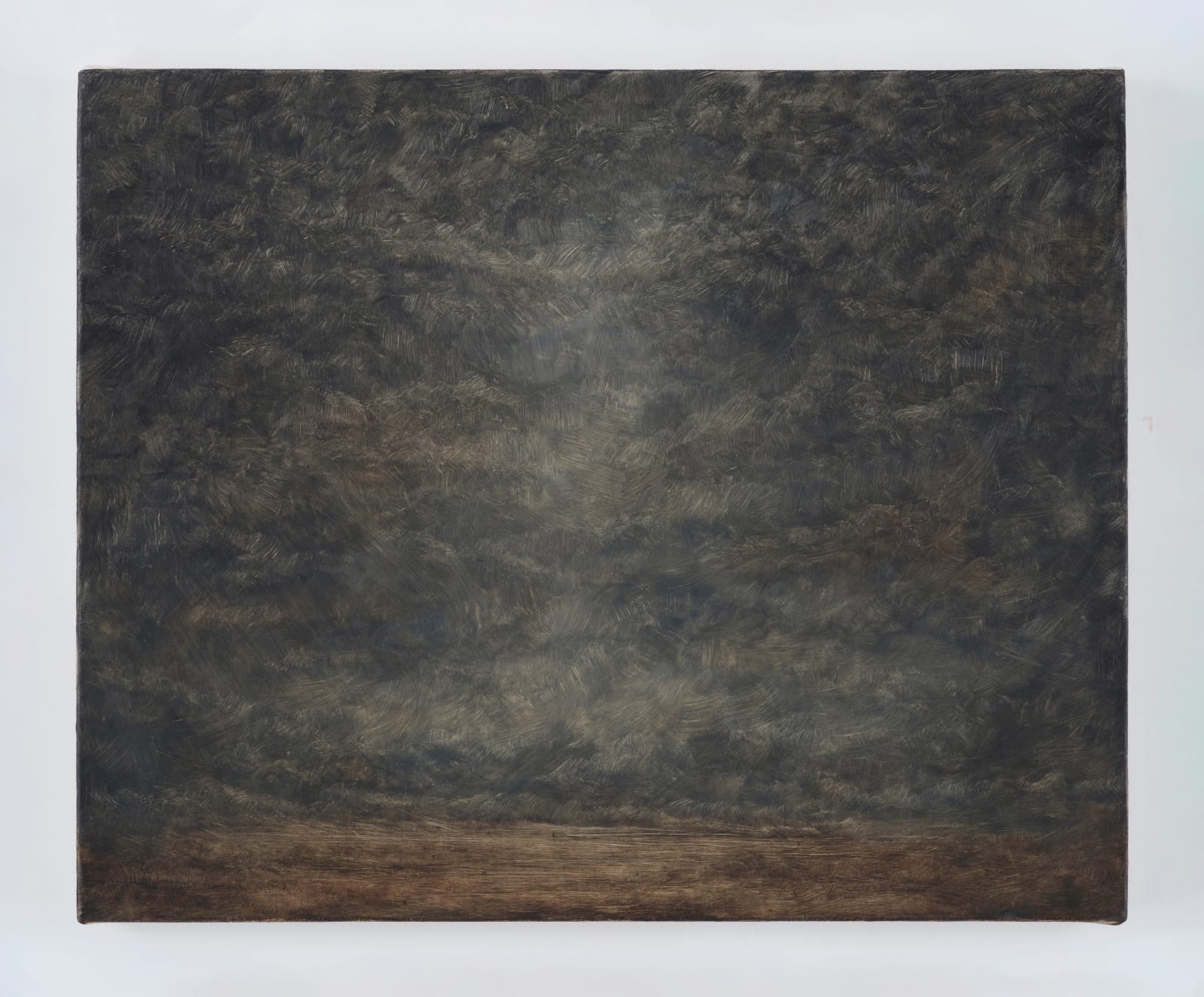
Lucas Arruda Brazilian , 1983
Untitled, 2016
Acrylic on canvas
36 x 37 cm. (14 1/8 x 14 5/8 in.)
Copyright The Artist
Further images
Lucas Arruda’s Untitled (2016) is a work of haunting subtlety, it stands as a quietly arresting statement within the artist’s broader practice: a body of painting that conjures spaces not...
Lucas Arruda’s Untitled (2016) is a work of haunting subtlety, it stands as a quietly arresting statement within the artist’s broader practice: a body of painting that conjures spaces not of geography, but of psyche. For more than fifteen years now, the artist has been producing a serial body of work composed of small-format paintings he calls Deserto-Modelo (Models of Desert). The title is a term borrowed from the Brazilian poet João Cabral de Melo Neto, and these works depict imaginary landscapes, inner visions painted from memory in his studio. They are never created “sur le motif” or based on photographs, but are always mnemonic reconstructions that stray into abstraction. Arruda’s landscapes are not depictions of actual places; rather, they are meditative projections of mental weather rendered in oil.
In Untitled, as in much of Arruda’s work, the subject is an imagined seascape, suspended between memory and invention. The composition is stripped back: a blurred horizon, a muted palette of greys and pale umbers, the faint shimmer of moonlight permeating layers of atmospheric haze. The painting is deliberately ambiguous. We are not meant to locate ourselves, but to lose ourselves into the ambiguous space between light and dark, presence and absence.
Arruda engages with the tradition of landscape painting, drawing on its Romantic lineage while simultaneously distilling it to its essence. He nods to the 17th-century notion of the sublime – a term associated with awe, terror, and transcendence – yet subverts the grandeur traditionally associated with it. His canvases, often modest in scale, resist the monumental in favour of the intimate. “It’s more powerful to contain something as immense as a seascape in a tighter scale,” Arruda has said. “It increases and concentrates the radiation, and the surrounding frequency.”
Rather than layering the canvas in traditional fashion, Arruda often employs methods of reduction. The horizon line in Untitled, for example, is not constructed by direct mark-making but suggested by the mere wiping of a cloth or brush. His work recalls the atmospheric lyricism of John Constable, the intimate, observational qualities of Claude Lorrain, and the expressive colouring of J.M.W. Turner.
In Untitled, the seascape appears to hover on the edge of visibility, held together by a fragile chemistry of light and tone. The distortion of colour – the deliberate lack of vivid hue – only heightens the viewer’s sensory engagement. Arruda is not interested in fidelity to nature, but in evoking the impression of experience, the memory of a place one has never visited, but somehow recognises.
Arruda’s contribution to contemporary painting has been widely acknowledged. His work now resides in major international collections including the Solomon R. Guggenheim Museum, New York; the J. Paul Getty Museum, Los Angeles; and the Rubell Family Collection, Miami.
Untitled exemplifies Arruda’s radically contemporary engagement with the landscape tradition. His works do not depict the world, rather, they distil states of mind, making the invisible currents of consciousness almost tangible.
In Untitled, as in much of Arruda’s work, the subject is an imagined seascape, suspended between memory and invention. The composition is stripped back: a blurred horizon, a muted palette of greys and pale umbers, the faint shimmer of moonlight permeating layers of atmospheric haze. The painting is deliberately ambiguous. We are not meant to locate ourselves, but to lose ourselves into the ambiguous space between light and dark, presence and absence.
Arruda engages with the tradition of landscape painting, drawing on its Romantic lineage while simultaneously distilling it to its essence. He nods to the 17th-century notion of the sublime – a term associated with awe, terror, and transcendence – yet subverts the grandeur traditionally associated with it. His canvases, often modest in scale, resist the monumental in favour of the intimate. “It’s more powerful to contain something as immense as a seascape in a tighter scale,” Arruda has said. “It increases and concentrates the radiation, and the surrounding frequency.”
Rather than layering the canvas in traditional fashion, Arruda often employs methods of reduction. The horizon line in Untitled, for example, is not constructed by direct mark-making but suggested by the mere wiping of a cloth or brush. His work recalls the atmospheric lyricism of John Constable, the intimate, observational qualities of Claude Lorrain, and the expressive colouring of J.M.W. Turner.
In Untitled, the seascape appears to hover on the edge of visibility, held together by a fragile chemistry of light and tone. The distortion of colour – the deliberate lack of vivid hue – only heightens the viewer’s sensory engagement. Arruda is not interested in fidelity to nature, but in evoking the impression of experience, the memory of a place one has never visited, but somehow recognises.
Arruda’s contribution to contemporary painting has been widely acknowledged. His work now resides in major international collections including the Solomon R. Guggenheim Museum, New York; the J. Paul Getty Museum, Los Angeles; and the Rubell Family Collection, Miami.
Untitled exemplifies Arruda’s radically contemporary engagement with the landscape tradition. His works do not depict the world, rather, they distil states of mind, making the invisible currents of consciousness almost tangible.
